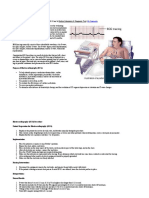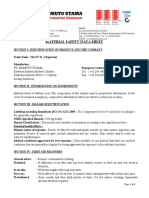Appendix: I. Indications
Appendix: I. Indications
Uploaded by
rudolfpeterssonCopyright:
Available Formats
Appendix: I. Indications
Appendix: I. Indications
Uploaded by
rudolfpeterssonOriginal Description:
Original Title
Copyright
Available Formats
Share this document
Did you find this document useful?
Is this content inappropriate?
Copyright:
Available Formats
Appendix: I. Indications
Appendix: I. Indications
Uploaded by
rudolfpeterssonCopyright:
Available Formats
APPENDIX
APPENDIX: N TITLE: CARDIAC MONITORING PROCEDURES REVISED: 15 April 2006
I. INDICATIONS:
Patients at risk for dysrhythmias shall receive continuous EKG monitoring. A rhythm strip shall accompany each EKG rhythm interpreted in written patient reports. A 12 Lead EKG shall be obtained when appropriate. A PARAMEDIC SHALL ATTEND ALL PATIENTS REQUIRING CONTINUOUS EKG MONITORING. All patient contacts requiring the use of an EKG, continuous or otherwise, shall be signed by at least one paramedic. If the chart is written by an EMT, the paramedic will co-sign the chart.
II. CONTRAINDICATIONS:
NONE
III. PROCEDURE:
Limb Lead placement: - Place electrodes in the standard Lead II configuration. (One between the right nipple and the clavicle, one between the left nipple and the clavicle, and one in the "Apex" area, between the left nipple and the iliac crest). - As an alternative, place the appropriate leads on the anterior aspects of the appropriate limbs. This is especially useful when a 12-Lead EKG is anticipated. - Attach the black wire to the left-arm electrode (Ground), the white wire to the right-arm electrode (Negative), and the red wire to the left leg electrode. (Positive). If present, the green wire is attached to the right leg electrode, and the brown wire is attached to the chest electrode in the V1 position. - Turn the control switch to the desired lead position. 12-LEAD EKG PLACEMENT: Limb leads are placed on a non-bony part of the distal anterior aspect of the appropriate extremity. Chest leads are placed as follows, shave and gently abrade the area as needed. Left chest leads V1: fourth intercostal space just right of the sternum V2: fourth intercostal space just left of the sternum V3: fifth rib, between V2 and V4 V4: fifth intercostal space, midclavicular line V5: fifth intercostal space, anterior axillary line V6: fifth intercostal space, midaxillary line
CARDIAC MONITORING
APPENDIX
N
Right chest leads: (Optional) Placed in corresponding position on the right side of the chest. Documented as V3R, V4R, etc. (V4R is preferred) Posterior chest leads (V7-V9) (Optional) V7: Posterior axillary line, fifth intercostal space V8: Midscapular line, fifth intercostal space V9: Left of the vertebrae, fifth intercostal space 12-LEAD EKG RULES TO LIVE BY Watch for reciprocal (mirror image) changes opposite the site of a suspected MI Inferior MI with reciprocal changes in V1-V2, consider posterior MI Inferior MI with decreased B/P, decreased heart rate, consider right-sided MI. This is especially true if ST elevation is greater in lead III than lead II. About 30% of left inferior MIs are also right-sided MIs Apparent A-Fib with regular R-Rs, consider digoxin toxicity Right-sided MIs may need fluids before nitrates.
CARDIAC MONITORING
IV. SPECIAL CONSIDERATIONS:
- Limb lead EKG monitoring is for rhythm interpretation only. A 12-lead must be obtained to document diagnostic EKG changes (ST segment changes, Q waves, etc.). - If a 12-lead EKG is not available, a Modified Chest Lead (MCL) may be obtained by monitoring lead III and placing the left leg electrode in the V1, V4, or V6 position. This shall be documented as MCL-1/4/6. - The diagnostic 12-lead EKG is intended to assist in the recognition of infarction and dysfunction. A normal 12-lead EKG does not preclude the presence of an MI. A 12-lead EKG may be a valuable tool to document response to treatments, triage patient severity and destination, and decrease time to definitive treatment. - The acquisition of a 12-lead EKG should not significantly delay treatment or transport. - When possible, the 12-lead EKG should be transmitted to the receiving hospital with the patients name if possible as time permits. When possible, use the software in the 12 lead EKG to label the 12 lead with the patients name prior to transmission of the 12 lead.
You might also like
- EKG | ECG Interpretation. Everything You Need to Know about 12-Lead ECG/EKG InterpretationFrom EverandEKG | ECG Interpretation. Everything You Need to Know about 12-Lead ECG/EKG InterpretationRating: 3 out of 5 stars3/5 (1)
- ECG/EKG Interpretation: An Easy Approach to Read a 12-Lead ECG and How to Diagnose and Treat ArrhythmiasFrom EverandECG/EKG Interpretation: An Easy Approach to Read a 12-Lead ECG and How to Diagnose and Treat ArrhythmiasRating: 5 out of 5 stars5/5 (3)
- PM - 12-Lead ECG For Monitoring & Diagnostic Use Rel. H.0 4522 962 57531 - AnDocument28 pagesPM - 12-Lead ECG For Monitoring & Diagnostic Use Rel. H.0 4522 962 57531 - Anprzy3_14No ratings yet
- ECG Skill LabDocument37 pagesECG Skill LabNayyer Khan100% (1)
- Electrocardiography Is The Most Commonly Used Test For EvaluatingDocument5 pagesElectrocardiography Is The Most Commonly Used Test For Evaluatingmyk_1102No ratings yet
- 12 Lead EKG PlacementDocument1 page12 Lead EKG PlacementBamikeh John AfrikNo ratings yet
- Purpose: Cardiac MonitoringDocument6 pagesPurpose: Cardiac Monitoringpramod kumawatNo ratings yet
- Electrocardiogra M (ECG) : Prepared byDocument30 pagesElectrocardiogra M (ECG) : Prepared byBindiya RbNo ratings yet
- 12 Lead ECGDocument31 pages12 Lead ECGpop lopNo ratings yet
- Electrocardiogram12 LeadsDocument28 pagesElectrocardiogram12 LeadsshyluckmayddpNo ratings yet
- Electrocardiogram Nursing ResponsibilitiesDocument28 pagesElectrocardiogram Nursing ResponsibilitiesKristine Jade Rojas100% (1)
- ELECTROCARDIOGRAMDocument3 pagesELECTROCARDIOGRAMMonica Jubane100% (1)
- Basic ECGDocument152 pagesBasic ECGTuấn Thanh VõNo ratings yet
- Revise ELECTROCARDIOGRAM MONITORINGDocument2 pagesRevise ELECTROCARDIOGRAM MONITORINGsenyorakath100% (1)
- 12 Lead Electrocardiogram (Ecg) Placement: Module DescriptionDocument11 pages12 Lead Electrocardiogram (Ecg) Placement: Module DescriptionHanna La MadridNo ratings yet
- Electrocardiogram (EKG or ECG)Document12 pagesElectrocardiogram (EKG or ECG)श्रीकृष्ण हेङ्गजूNo ratings yet
- The Wiring Diagram of The HeartDocument4 pagesThe Wiring Diagram of The Heartgurneet kourNo ratings yet
- Ecg Leads System New 2018-1Document35 pagesEcg Leads System New 2018-1kambohlaiba387No ratings yet
- ECG PlacementDocument2 pagesECG Placementvin_XVIIINo ratings yet
- ECG (Dr. Abdulstar)Document32 pagesECG (Dr. Abdulstar)Osamah AbdullahNo ratings yet
- 12 Lead ECGDocument9 pages12 Lead ECGVinz Khyl G. CastillonNo ratings yet
- ElectrocardiographyDocument4 pagesElectrocardiographyJho BuanNo ratings yet
- Right Side EcgDocument4 pagesRight Side EcgDragos CirsteaNo ratings yet
- Clinical ElectrocardiographyDocument134 pagesClinical ElectrocardiographyHossain MuhammadNo ratings yet
- Electrocardiogram (ECG or EKG) : Danilyn R. Cenita Paula M. PauloDocument41 pagesElectrocardiogram (ECG or EKG) : Danilyn R. Cenita Paula M. PauloDhanNie CenitaNo ratings yet
- ElectrocardiogramDocument2 pagesElectrocardiogramEd LadabanNo ratings yet
- ECGDocument62 pagesECGSanju TanwarNo ratings yet
- 12 Lead Ecg PlacementsDocument9 pages12 Lead Ecg Placementskim reyesNo ratings yet
- 12 Lead Ecg Placements The HeartDocument9 pages12 Lead Ecg Placements The HeartFalusi Blessing OlaideNo ratings yet
- EcgDocument45 pagesEcgkamel6No ratings yet
- ElectrocardiogramDocument17 pagesElectrocardiogramvinnu kalyanNo ratings yet
- The 12-Lead ElectrocardiogramDocument16 pagesThe 12-Lead ElectrocardiogramGrace Rivera GuarinNo ratings yet
- Ecg Treadmill and Holter TestDocument77 pagesEcg Treadmill and Holter TestRiteka Singh100% (1)
- Electrocardiogram (Ecg or Ekg) : - 2 Components of ELECTRODESDocument4 pagesElectrocardiogram (Ecg or Ekg) : - 2 Components of ELECTRODESDhanNie CenitaNo ratings yet
- 12 LeadecgDocument3 pages12 LeadecgAnkit AgarwalNo ratings yet
- Chapter 3 ECG Principles (1)Document18 pagesChapter 3 ECG Principles (1)perpetualsuccoreropdNo ratings yet
- 5 EcgDocument31 pages5 EcgMarceline GarciaNo ratings yet
- Arrhythmia InstructorDocument25 pagesArrhythmia InstructorPeter Arnold Tagimacruz Tubayan100% (1)
- What Is The Definition of Electrocardiogram/ECG?Document4 pagesWhat Is The Definition of Electrocardiogram/ECG?Kyle AndrewNo ratings yet
- Guideline Title: Cardiac Monitoring in ICUDocument14 pagesGuideline Title: Cardiac Monitoring in ICURirin RozalinaNo ratings yet
- Ecg BasicDocument48 pagesEcg BasicsardimonNo ratings yet
- How to Perform ECG.pptx(1)Document32 pagesHow to Perform ECG.pptx(1)ashley MuchatutaNo ratings yet
- Bipolar Limb Leads (Frontal Plane)Document7 pagesBipolar Limb Leads (Frontal Plane)jonna casumpangNo ratings yet
- Ecg PlacementDocument7 pagesEcg PlacementOliver Bagarinao100% (1)
- 12-Lead ECG Monitoring With EASI PDFDocument14 pages12-Lead ECG Monitoring With EASI PDFalghashm001No ratings yet
- ECGfinalDocument10 pagesECGfinalSarah FerguzonNo ratings yet
- Recording the ECG ECG Basics - MedSchoolDocument1 pageRecording the ECG ECG Basics - MedSchoolLonely gladiatorNo ratings yet
- 110 Ekg.1.8.2014. Ifn - Icp PDFDocument27 pages110 Ekg.1.8.2014. Ifn - Icp PDFAshleyNo ratings yet
- 12-Lead ECG PlacementDocument2 pages12-Lead ECG PlacementRosebud RoseNo ratings yet
- Unit 2 BmiDocument188 pagesUnit 2 Bmiaarthir88No ratings yet
- Practical 2: Electrocardiogram (Ecg/Ekg) : by - Mohamad Azmir Bin Azizan Medical Lab Technologist Faculty of Medicine UitmDocument19 pagesPractical 2: Electrocardiogram (Ecg/Ekg) : by - Mohamad Azmir Bin Azizan Medical Lab Technologist Faculty of Medicine UitmraburtonNo ratings yet
- Basic ECG moduleDocument115 pagesBasic ECG moduleDennis lasat IINo ratings yet
- Topic:: Performing and Interpreting Electrocardiogram (ECG)Document137 pagesTopic:: Performing and Interpreting Electrocardiogram (ECG)Tiffany AdriasNo ratings yet
- Introduction To ECG For NursingDocument75 pagesIntroduction To ECG For NursingRashid AlHamdan100% (1)
- EKG Basics HandoutDocument8 pagesEKG Basics HandoutDuy JzNo ratings yet
- Ecg Utah EduDocument87 pagesEcg Utah EduMos Viorel DanutNo ratings yet
- Basics of Ecg InterpretationDocument76 pagesBasics of Ecg InterpretationDennis Miriti100% (1)
- Counseling Techniques FINAL 11-12-08Document1 pageCounseling Techniques FINAL 11-12-08rudolfpeterssonNo ratings yet
- Engine Test Bed: SolteqDocument4 pagesEngine Test Bed: SolteqrudolfpeterssonNo ratings yet
- 1.3 Disaster Management: Impact of TsunamiDocument12 pages1.3 Disaster Management: Impact of TsunamirudolfpeterssonNo ratings yet
- 2012 Holidays by Location1Document3 pages2012 Holidays by Location1rudolfpeterssonNo ratings yet
- 24x7 PHC TN ModifiedDocument33 pages24x7 PHC TN Modifiedrudolfpetersson80% (5)
- 49CDocument154 pages49Crudolfpetersson100% (2)
- 05 N002 28713Document20 pages05 N002 28713rudolfpeterssonNo ratings yet
- Design Engineer Fluid Handling Crane Pumps & Systems, Inc. Piqua, Ohio Engineering Manager OperationsDocument2 pagesDesign Engineer Fluid Handling Crane Pumps & Systems, Inc. Piqua, Ohio Engineering Manager OperationsrudolfpeterssonNo ratings yet
- Functional Assessment of Cancer Therapy-Brain Questionnaire: Translation and Linguistic Adaptation To Brazilian PortugueseDocument6 pagesFunctional Assessment of Cancer Therapy-Brain Questionnaire: Translation and Linguistic Adaptation To Brazilian PortugueserudolfpeterssonNo ratings yet
- Die Validation of Fuel Tank Using: Hyperform 7.0Document22 pagesDie Validation of Fuel Tank Using: Hyperform 7.0rudolfpeterssonNo ratings yet
- Assembly DrawingDocument55 pagesAssembly DrawingKantharaj ChinnappaNo ratings yet
- TCO Nov-2010, RCMSDocument80 pagesTCO Nov-2010, RCMSQuốc Tiến TrịnhNo ratings yet
- Theories of AgingDocument14 pagesTheories of AgingTrixie Gulok100% (1)
- A Five-Factor Measure of Obsessive-Compulsive Personality Traits PDFDocument38 pagesA Five-Factor Measure of Obsessive-Compulsive Personality Traits PDFRANJINI.C 20PSY042No ratings yet
- Job Description of HSE SupervisorDocument2 pagesJob Description of HSE Supervisorsharpblade82No ratings yet
- Ophthalmology Outpt Note 04-09-2024Document10 pagesOphthalmology Outpt Note 04-09-2024greenwoodm66No ratings yet
- Professional Nursing Professional Nursing in The Philippines in The PhilippinesDocument92 pagesProfessional Nursing Professional Nursing in The Philippines in The PhilippinesPia Rose RoqueNo ratings yet
- Childrens Uniform Mental Health Assessment CUMHA 1Document14 pagesChildrens Uniform Mental Health Assessment CUMHA 1Hira WarsiNo ratings yet
- Title of Journal Reviewed: Reaction: (300 500 Words)Document3 pagesTitle of Journal Reviewed: Reaction: (300 500 Words)AJ TaoataoNo ratings yet
- CHELITISDocument25 pagesCHELITISFaiza LailiyahNo ratings yet
- Euros HM StandardDocument12 pagesEuros HM StandardMohamed AdamNo ratings yet
- PSI 2 Research Bibliography1Document10 pagesPSI 2 Research Bibliography1Mike ShufflebottomNo ratings yet
- JSA For ExcavationDocument3 pagesJSA For Excavationwahyu nugrohoNo ratings yet
- Rewriting Life Stories Michael WhiteDocument5 pagesRewriting Life Stories Michael WhiteroulazNo ratings yet
- ProviderFS NarcolepsyDocument2 pagesProviderFS Narcolepsyسعيد المفرجيNo ratings yet
- Principles and Practice of Clinical Research. ISBN 0128499052, 978-0128499054Document23 pagesPrinciples and Practice of Clinical Research. ISBN 0128499052, 978-0128499054nellclementinauak100% (15)
- Endometriosis Care in Wales1Document81 pagesEndometriosis Care in Wales1Mary De la HozNo ratings yet
- Get Cleft and Craniofacial Orthodontics 1st Edition Pradip R. Shetye free all chaptersDocument67 pagesGet Cleft and Craniofacial Orthodontics 1st Edition Pradip R. Shetye free all chapterskamulijuvy100% (1)
- Tusla - Short Guide For Parents Who Are Newly Arrived in Ireland 1Document16 pagesTusla - Short Guide For Parents Who Are Newly Arrived in Ireland 1pr.danilovaNo ratings yet
- Antipsychotic Prescribing Guidelines For Schizophrenia Updated Table March 2017 1500556433Document17 pagesAntipsychotic Prescribing Guidelines For Schizophrenia Updated Table March 2017 1500556433larissa.calvoNo ratings yet
- 2.3.1 Sustainable Leadership: Objectives Learning OutcomesDocument5 pages2.3.1 Sustainable Leadership: Objectives Learning Outcomesapi-592321269No ratings yet
- Titration Solvent MSDSDocument9 pagesTitration Solvent MSDSFitriani TanraNo ratings yet
- Material Safety Data Sheet: Page 1 of 4Document4 pagesMaterial Safety Data Sheet: Page 1 of 4Randy IpNo ratings yet
- CV FormatDocument3 pagesCV Formatafridi247365No ratings yet
- Perdev Third Quarter TosDocument2 pagesPerdev Third Quarter TosAbegail TanhusayNo ratings yet
- AIML Exp5 VivekDocument5 pagesAIML Exp5 VivekvivekagangwaniNo ratings yet
- Public Health UnitDocument2 pagesPublic Health UnitMark Emil BautistaNo ratings yet
- Flux Core Welding WireDocument3 pagesFlux Core Welding Wiremuhamad bukhari abu hassanNo ratings yet
- Hub and Spigot Installation ProceduresDocument9 pagesHub and Spigot Installation ProceduresBruce DoyaoenNo ratings yet
- ACP XII PsychologyDocument6 pagesACP XII Psychologypooja chhibberNo ratings yet
- ADHD Across Life Span InfographicDocument1 pageADHD Across Life Span InfographicKida7No ratings yet




































































































